- HOME
- Research
- Past Works
- Mathematical models for pattern formation of leaf vascular networks.
Past Works
Mathematical models for pattern formation of leaf vascular networks.
The vascular system of plant is a network of bundles that connects within major organs. The development or differentiation of vascular system is one of the most important subjects in botany, and a lot of studies have focused the problem. In dicot systems, veins in a leaf are usually diverse in their size and they can be classified distinctively by their appearance. The largest vein located at the center of a leaf is called midvein (or primary vein), which are generated first. Veins differentiate progressively in an early developmental stage of leaf. A vein, which is continuous with stem vascular bundle, extends starting from proximal edge to distal end of the leaf, and then become a midvein. Secondary veins are generated from branches from the midvein and are thinner than the midvein. By repeating branching and extension, higher order veins are generated sequentially with growth of leaf and the reticulate network system is formed. Although a lot of experimental studies have attempted to identify the mechanism of vascular patterning in leaves, it is still a problem to solve. Jacobs revealed the importance of auxin for vascular differentiation. Auxin is one of the major plant hormones. In the higher plant, indole acetic acid (IAA) is one of the most important auxin chemicals. Auxin is diffusible molecule; however, it is considered that auxin is also transported along the particular direction, usually from apical to basal in a stem, from distal to proximal in a leaf. It is called auxin polar transport. In a leaf, auxin is considered to be produced in apical margins of leaves and transported toward the proximal regions. Many researchers considered that such auxin flow play important role in vascularization of plant.
Three hypotheses have been proposed so far to explain the leaf venation pattern formation. One is auxin canalization hypothesis proposed by T. Sachs that is based on the assumption of the positive feedback regulation between auxin flow and flow capacity. Auxin is a diffusible plant hormone of small molecule and has important roles in various developmental events including vascular differentiation in plants. In this hypothesis, auxin pathways are expected to be generated from a uniform field and are extended in a sequential manner. The second is activator-inhibitor type reaction-diffusion hypothesis proposed by H. Meinhardt that is based on two interactive factors of weakly diffusible activator and strongly diffusible inhibitor. We proposed the third hypothesis, substrate-depletion type reaction-diffusion model, that is based on two interactive factors of strongly diffusible auxin resource and its consumer.

On the other hand, we tried to integrate the canalization hypothesis and the experimental knowledge. we introduce auxin transport by PIN1 efflux carrier into the auxin canalization hypothesis. So we investigated a model based on the assumption of the positive feedback regulation between auxin flow and PIN1 localization. The substrate-depletion type reaction-diffusion model can regenerate growth and branching patterns. On the other hand, the canalization model can generate closed circuits of leaf veins under a condition. Both two mechanisms seem to be responsible for the leaf vein formation (Fujita, H. & Mochizuki, A. (2006) The Origin of the Diversity of Leaf Venation Pattern. Dev. Dyn. 235, 2710-2721. Fujita, H. & Mochizuki, A. (2006) Pattern formation by the positive feedback regulation between flow of diffusible signal molecule and localization of its carrier. J. theor. Biol.241, 541-551.).

